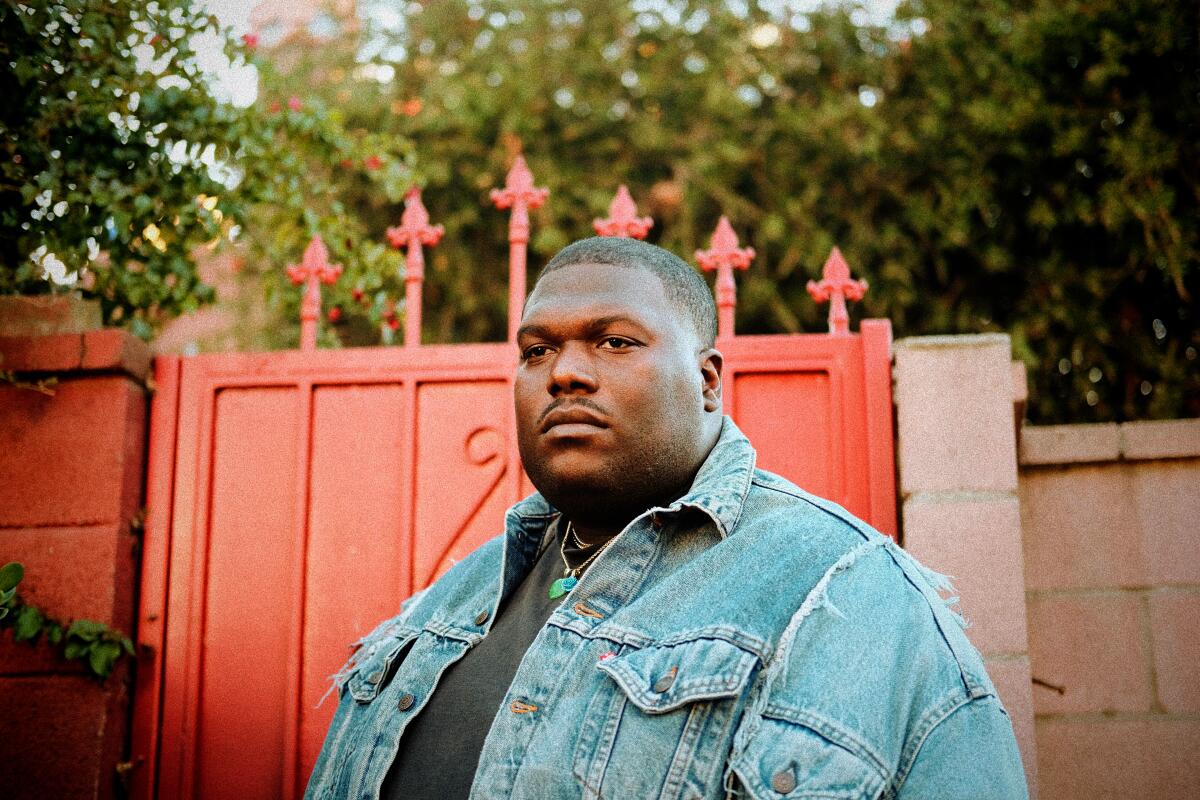L.A. hitmaker’s red hat led accused killers to mistake him for gang rival, police say

- Share via
Ray Jacobs, a singer who co-wrote hits for Justin Bieber and DJ Khaled, had just left a West Adams bar when a silver Chevrolet Impala and white Mercedes-Benz SUV pulled alongside.
Muzzle flashes erupted from the cars’ open windows, a Los Angeles Police Department officer testified at a hearing last month.
Jacobs, 31, who performed under the name August 08, was killed Aug. 26, 2023, in what prosecutors assert was a case of mistaken identity.
Sidney Barrett Morris, who held a high-level post at Cal State Northridge, was gunned down as he ate dinner on Nov. 28, 2023. The suspected killers appeared in court recently, but a motive in the crime remains unclear.
The alleged shooters — members of the Rollin’ 30s Harlem Crips — believed Jacobs was associated with the Black P-Stones, a rival Bloods gang, a prosecutor said at the hearing.
Jacobs wasn’t affiliated with any gang — but prosecutors said he was wearing a baseball cap with a red brim.
The prosecution’s theory of why Jacobs was targeted is a throwback to a more violent era. Los Angeles — and in particular, the West Adams neighborhood where Jacobs was killed — is a far safer place than it was in the 1990s, when the city saw more than 1,000 homicides a year.
With modern gang beefs often starting as spats on social media and spilling over into targeted violence, indiscriminate shootings are less common.
Attorneys representing the alleged killers argued there is no evidence, just speculation about the color of a hat, to suggest Jacobs was mistaken for a gang member.
But in the prosecution’s telling, Jacobs’ case shows gentrification and plummeting homicide numbers haven’t changed the fact that a young Black man can still be killed for wearing the wrong color in the wrong neighborhood.
Jacobs, who grew up in Long Beach and Lynwood, found success in 2015 co-writing the hit “I’m the One” with Bieber and Khaled.
An early member of the 88Rising music collective, Jacobs released his debut solo EP, “Father,” in 2018, The Times reported. He later signed with Def Jam Recordings, which produced a 2022 LP, “Seasick,” that included collaborations with Jhené Aiko, Schoolboy Q and Joji.
In a statement after his death, Jacobs’ record label called him a “brilliant songwriter, an accomplished musician and a singular artist.”
Hours after Jacobs was killed, Officer Daniel Ivan of the Los Angeles Police Department went to Cedars Sinai Medical Center to interview the singer’s friend, who’d been wounded in the same incident.
Lanai Dees was driving her white Mercedes Benz in an alley off Century Boulevard in the Westmont neighborhood last November when someone in a dark-colored SUV opened fire, investigators said Thursday.
The friend said they’d gone to the Bar at Johnny’s, a beer and wine spot attached to Johnny’s Pastrami. The longtime sandwich stand, which closed in 2015, reopened five years later as part of a revitalization of the West Adams neighborhood.
Just before the bar closed, the friend said, he and Jacobs walked two women they’d met that night to their cars. As they crossed the street, the friend heard gunfire — 15 to 20 shots, Ivan testified. Shot in both legs, he hid behind a trash can. Jacobs stumbled, then collapsed.
The friend did not see the shooters, Ivan testified.
Using surveillance footage, Ivan determined the killers drove an Impala and Mercedes-Benz sport utility vehicle. The registered owner of the Impala was Garey Marshall, then 42, the officer testified. The SUV was rented through the Turo car-sharing app to the girlfriend of Grady Montgomery, then 34, according to Ivan.
Both Marshall and Montgomery are members of the Rollin’ 30s, the officer testified.
Ivan said both cars and both men were captured on surveillance video at Martin Luther King Jr. Park, a hangout for the Rollin’ 30s, shortly before Jacobs was killed.
Marshall and Montgomery were seen at the park wearing white shirts, Ivan said, and the surveillance video, although grainy, showed the shooters wore white shirts. Marshall’s phone records showed that he traveled toward West Adams before Jacobs was killed, according to Ivan.
Gabriel De Alba, an LAPD officer who monitors the Rollin’ 30s, testified that the gang started in the 1970s as a group called The Armed Godfathers. Its territory now stretches from Jefferson to King boulevards and from Normandie Avenue to Crenshaw Boulevard, De Alba said.
Federal prosecutors say the fearsome reputation of the Rollin’ 60s gang allowed Eugene “Big U” Henley to intimidate businesses and people for decades.
De Alba testified to support a gang enhancement against Marshall and Montgomery, who have pleaded not guilty to charges of killing Jacobs and attempting to murder his friend.
Los Angeles County Dist. Atty. Nathan Hochman has authorized prosecutors to file the enhancements — which increase prison terms if prosecutors prove that the crime benefited a gang — after his predecessor, George Gascon, banned their use.
The Rollin’ 30s’ enemies include the Black P-Stones, who claim the area where Jacobs was killed, De Alba said. The Black P-Stones often wear red, although De Alba said gangs no longer color code as strictly as they once did.
Zino Osehobo, an attorney for Marshall, said it was pure speculation that his client was even at Jacobs’ killing, much less that he was a shooter.
“I can’t even call it circumstantial evidence,” he said in asking Superior Court Judge Craig Veals to dismiss the murder charges. “It’s an assumption-based case.”
Deion Benjamin, who represents Montgomery, said there was “no evidence” to support a gang enhancement. The mere fact someone was killed in a place that a gang possibly considers its territory doesn’t make it a gang crime, Benjamin told the judge.
Veals disagreed, ruling he’d seen enough evidence for Montgomery and Marshall to stand trial on charges of murder and attempted murder with the gang enhancement.
It was “completely plausible” that the defendants mistook Jacobs and his friend for rivals “given the color of the cap in question,” the judge said. “Sure, there are issues here. It’s a circumstantial case. It’s not a weak one by any stretch.”
More to Read
Sign up for Essential California
The most important California stories and recommendations in your inbox every morning.
You may occasionally receive promotional content from the Los Angeles Times.













